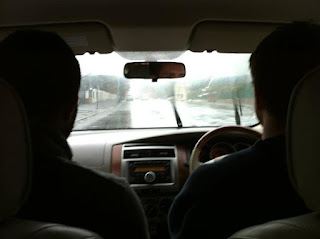This blog entry is about two foster mothers Matt and I interviewed during our time working with Ikamva Labantu. I hope to share their stories with you not only to give you more specific cases we deal with in our work, but also raise the question of "how should we better help these foster mothers". The later inspires me to write my final report on the shortage of social workers worldwide.
 |
| Children playing in the yard |
When we parked the car at the
door of Mapapu's home, I had this feeling of visiting another one of the
crèches we were visiting those days. Six
or seven boys around the same age were playing in the front yard and they could
just have been students in a small-sized crèche; as we walked in her home, we
saw more children. This time they were
of different ages. One of the little
ones was in the arm of a teenage girl and the other one was in the arm of a
lady of my grandma's age. She is Mapapu,
our interviewee today, a foster mother in the Guguletu township in Cape Town,
South Africa.
 |
| We were weighting the children and measuring their heights to learn about their growth status. The lady in orange dress is Mapapu. |
Although she is the head of the
household, which was packed with more than twenty children, Mapapu was not
running an educare center. All these
children, from the months old to grown-ups, were her foster children. In another way of putting it, she was having
twenty children except many of them were not her blood relatives. It might be a blessing for the well-off
people who love kids to have twenty of them around. But for Mapapu who doesn't have a steady
income or a lot of savings, having twenty children under the roof of her
two-bedroom house means a lot of financial difficulties. To be more specific about this, just note
that in South Africa, the government gives 700 Rand to the foster mother for
taking care of each foster child.
However, due to the complexities of getting this grant, Mapapu was
raising more than twenty children with a grant of 2800 Rand every month. "Social workers came and drop the babies
at my door. All I could do was pick it
up and raise it as my own. Nobody ever
came back and took the child away. So I
just have more and more children."
When we asked about the legal custody of those children, Mapapu took out
some legal documents that state the expiration date of her custody. Even though some of those dates already
passed, no social worker came and helped her to update these documents. No legal custody means no grant, while the
social workers were all busy delivering new babies to her home. Mapapu had no choice but to spare the little
food they've got for additional children in her house.
 |
| Two little ones wearing T-shirt in the winter. I myself was wearing a puffy jacket. |
Limited money at home might just
suffice for food because the children were clearly out of winter clothes. In the middle of the winter in South Africa, some
of the children were wearing T-shirts, shorts and flip-flops. At some point
during our visit, the pipe in the front yard broke and the boys tried to save
the leaking water using basins, buckets and bottles. After the pipe was fixed, their thin T-shirts
were wet but no one went to change, probably because those were the only ones
they had.
 |
| Pipe broke and the children were saving the water. |
Monetary issues were not the only
problem Mapapu was facing. She started
tearing when we started to talk about the future of these children. She showed us a poster she made in 2011 that
tries to solicit donations from the society.
In the poster, she cried for old clothes, shoes, food and
adoptions. "Nothing came
back", her anxiety was all in her crying voices.
 |
| The poster Mapapu made |
Another foster mother, Vivian
Joba, who was taking care of eight children, worried about the same thing: what
the future of these children is like. She
was worrying about one of them especially.
This girl, who had been living with Joba since three months old, had a
car accident six months ago and broke her neck.
She was disabled and no one, not even Joba, knew her future. When I think about this tragedy further, I
realize that this is a tangled matter rather than mere misfortune. The accident happened when the girl was
playing on the street unattended. Because
Joba was taking care of more children beyond her physical ability, the girl was
not attended and thus gave chance for the accident to happen. The accident also increased Joba's dependency
on grant. However, six months passed by
and no social worker showed up to help her with the medical bill and special
care grant.
 |
| Joba's disabled little girl |
Ikamva Labantu is still
recruiting social workers but the shortage of social workers countrywide has
made it especially hard to recruit for NGOs who couldn't afford high pays due
to limited funding. I believe that I saw
problems in the foster care system from talking to Mapapu and Joba. But meanwhile, I am glad that I am for sure
not the only one who saw those problems.
I talked to my supervisor at Ikamva and she told me that Ikamva was
thinking of training community workers to do some of social workers' job. I sincerely wish that by the time next year's
group arrive at Ikamva Labantu, Mapapu and Joba will be no longer suffering
from their problems.


































